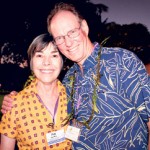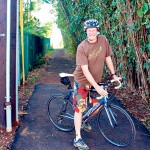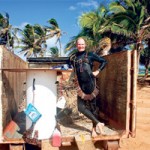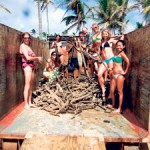Happy Noyes Year
Whether he’s leading volunteers in cleaning up underwater gunk (which explains his attire here), working to prevent childhood obesity, promoting community fitness or getting out and being active himself, Tommy Noyes sets an example of a dedicated and involved citizen of Kaua’i
Tommy Noyes is a man on the go to improve lives for everyone on Kaua’i. And for him, that makes a good life
It’s not yet sunrise and Tommy Noyes is about to engage in his weekly routine of backbreaking work: clearing out debris from Lydgate Beach Park swimming pond. Armed with two airlift pumps he’s fashioned himself and a truck bed packed with floats, chain and weights, Noyes has his Saturday volunteer cleanup program down to an art.
“I enjoy methodically thinking through complex problems and developing solutions through collaborative processes,” he says.
That explains the homemade tools he’s fashioned for part of this effort.
The generically named airlift pump devices – “Al” and “Bob” – look like pieces of functional art, which perhaps makes sense as Noyes was an art major at Stanford, (though engineering also was among his studies).
In addition to a handful of other volunteers, Noyes’ daunting task on this wind-whipped December morning will be achieved with the help of these innovations he’s created from scratch – they will suck out underwater debris as he is submerged in the frigid, blown-out pond that is Lydgate.
He has served as volunteer general coordinator for the Friends of Kamalani and Lydgate Park for 19 years, and is about to remove a roll-off trash container’s worth of organic, murk-creating debris from the ocean, something the “Friends” do every Saturday.
Noyes is used to rolling up his sleeves, though, and believes in the benefits of physical activity – a recurring theme in how he spends his time.
Originally from Woodstock, Ill., Noyes was raised on a small organic farm.
“My earliest memories are of the hard work, reliance on a trustworthy team, and the many different skills a farmer must creatively apply in order to operate successfully,” he says. “Caring for the livestock, deciding when to plant and how to efficiently harvest a crop, keeping machinery functional, and staying safe in a potentially dangerous environment are all deeply engrained in my world view.”
Noyes divides much of his time among ways to promote a healthier lifestyle for local residents. That includes working to prevent obesity as part of the Communities Putting Prevention to Work national initiative, and advocating for Ke Ala Hele Makalae, the multiuse path that most recently added a segment along Papaloa Road. As the Hawaii coordinator for CPPW, Noyes targeted the obesity problem on Kaua’i and Maui by promoting healthier alternatives to sugar-loaded beverages and raising awareness of the health risks associated with being over-weight. “Sugary drinks may seem harmless, but they cause type II diabetes and amputations,” he says.
Remember those recent TV ads about soda? (“pouring on the pounds”), and that radio jingle about taking the “L.E.A.P”? Those were just part of the promotion Noyes and the CPPW coalition put together.
“I worked with the CPPW-Hawaii coalition members to make the healthy choice the easy choice,” Noyes says. The CPPW project purchased time and space to convey its “Take the LEAP” (L-live healthy, E-eat well, A-be active, P- live pono every day) message promoting active healthy lifestyles. They also worked to establish community gardens, collaborated for safe routes to schools and offered workshops on how to make it easier for mothers to begin and then continue to breast-feed their infants for at least the recommended first six months of the child’s life.
With the coalition, Noyes also helped educate businesses and residents on the benefits of infrastructure that is conducive to increased walking, bicycling, and the use of public transit. That’s where the multiuse path comes in, the most recent section of which was completed along the makai side of Kinipopo Shopping Village, heading north toward Kaua’i Sands. It’s all part of a smart-growth concept called “Complete Streets,” returning our communities to a more pedestrian-friendly environment for residents on an island with a predominant reliance on cars for almost all their daily transportation needs.
“It’s understandable that people are averse to change, to a multimodal transportation approach, but getting where you need to be without relying on a car is good for a number of reasons,” he says. “You stop and talk to people. You are getting exercise. You are one less car on the road impacting traffic. You are creating a smaller carbon footprint.”
Not one to think in small terms, Noyes was one of the advocates for making the multiuse path equestrian, too, on the segment just north of Kealia, though that didn’t get approved. “Yeah, it would have been really wonderful to include horses, in my opinion,” he says.
Statewide CPPW leader and state Rep. Dee Morikawa, who has been working to help sustain this initiative, says Noyes has been outstanding in the amount he’s accomplished when it comes to promoting a healthful lifestyle for local residents.
“Tommy is so passionate about people’s health,” she says. “His promotion of the bike path is crucial to our island, and the availability of safe bike routes goes hand in hand with that.”
Visioning paths has long been part of Noyes’ repertoire. He worked with the Kaua’i Planning and Action Alliance from 2005 to 2009 to rehabilitate neglected Kalalau Trail. “It had not been maintained, although it is an iconic and heavily used recreational facility,” Noyes says. It’s an experience that helped him refine his project management skills in contracting for the goods and services needed for the kind of larger-scale projects he’s working on now. (Now he simply text-messages his contacts for things like roll-off trash containers, keeping the momentum of his many projects going). Having several pots on the stove has proven to be a good method for him.
Much like the free “Tropic Care 2012” residents benefited from people like Noyes and Kaua’i district health officer Dr. Dileep G. Bal back in February and March, when the Pentagon’s Innovative Readiness Training military medical personnel were deployed and provided more than 8,000 individuals with free health care services. Active military personnel will be deployed to Kaua’i to design and build the elevated portion of the Americans With Disabilities Act (ADA)-compliant spur segment of Ke Ala Hele Makalae connecting Hudley Heights Park to the existing coastal section. This military civil engineering exercise will benefit the community with minimal, if any, cost to the county. The elevated section will be constructed with materials paid for with federal highway enhancement funds.
“At this stage I would expect construction on the spur to begin and be completed summer 2013,” Noyes says. “As a result of the ‘Safe Routes to School’ work accomplished under CPPW, the county is planning Complete Street treatments in the stretch between Hudley Heights Park and Kapahi Park.”
Also the bioterrorism preparedness planner for the Kaua’i Health District Office at the Department of Health, Noyes works to make sure that department personnel and volunteers in the Kaua’i Medical Reserve Corps are adequately trained and prepared for everything from a swine flu outbreak to an airliner crash or tsunami.
When Noyes does have a minute to himself, his answer to what he likes to do isn’t at all surprising: “I enjoy long-distance bicycling, hiking and devising innovative solutions to difficult problems,” he says.
That, and spending time with family, which includes wife Pat Griffin and sons Emory, a field botanist at National Tropical Botanical Garden, and Arthur, a tattoo artist at Far Syde Tattoo in Koloa – it seems both sons got a little bit of Noyes’ artistic and scientific sides. “We are blessed,” he says, “to have two self-reliant and talented sons.”
- Tommy Noyes prepares for a day of cleaning debris at Lydgate Beach Park
- With wife Pat Griffin
- Fronting the beach access portion that was ensured to be part of the most recent segment of the bike path shown here
- Noyes has invented several apparatuses used to clear underwater debris
- With ‘Save the Mermaids’ Romae Lenei, Tiana Kamen, Robin Fisher, Nicolai Barca, Rod Fisher, Lillie Donner, China Cisney and Rishalia Cert








